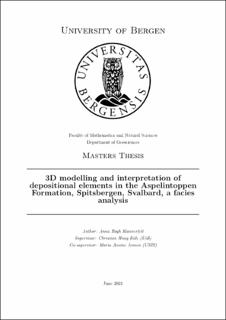| dc.contributor.author | Bøgh, Anna Rebecca Dyrlev | |
| dc.date.accessioned | 2021-07-03T00:11:19Z | |
| dc.date.available | 2021-07-03T00:11:19Z | |
| dc.date.issued | 2021-07-03 | |
| dc.date.submitted | 2021-07-02T22:00:10Z | |
| dc.identifier.uri | https://hdl.handle.net/11250/2763239 | |
| dc.description.abstract | The Aspelintoppen Formation is the youngest formation in the Central Tertiary Basin, a foreland basin in Spitsbergen. It comprises an up to 1000 m thick succession of near-coastal to continental deposits. Due to the high altitude and low accessibility of many localities where the formation cropsout, field studies have generally been limited. Published studies of the formation mostly deal with the fluvial-marine transition zone exposed at localities in Van Keulenfjorden, whereas development of the fluvial system has received limited attention. Recent developments in remote data collection using UAVs (unmanned aerial vehicles) and processing of high-resolution virtual outcrops makes the otherwise largely inaccessible Aspelintoppen Formation a perfect field laboratory to test the newly established sedimentological methods and to explore the development of large-scale floodplain deposits. In previous work, traditional fieldwork proved unsuitable for accurate channel dimensions and orientations to be determined, due to poor lateral accessibility along outcrops. Thus, recently developed methods in the form of drone and helicopter surveying are implemented for mapping the otherwise challenging outcrops. The sandstone bodies of the Aspelintoppen Formation are mapped on several locations in the Central Tertiary Basin, and the results are tied into already existing sedimentological and palaeobotanical data. The results of this study include a large image dataset and multiple high precision virtual outcrop models of Aspelintoppen Formation which provide valuable insight and can be used for future regional and locality-based studies of the formation. Furthermore, quantitative analyses of outcrop measurements reveal a thinning upwards pattern of the sandstone bodies within the floodplain deposits of the formation. In addition to sedimentological observations and statistics from this study and data from previous studies, the results indicate that the Aspelintoppen Formation was deposited in a prograding distributary fluvial system in a subsiding foreland basin with high sediment flux from the source of the West-Spitsbergen Fold and Thrust Belt. | |
| dc.language.iso | eng | |
| dc.publisher | The University of Bergen | |
| dc.rights | Copyright the Author. All rights reserved | |
| dc.subject | 3D modelling | |
| dc.subject | facies analysis | |
| dc.subject | floodplain | |
| dc.subject | central tertiary basin | |
| dc.subject | spitsbergen | |
| dc.subject | distributary fluvial system | |
| dc.title | 3D modelling and interpretation of depositional elements in the Aspelintoppen Formation, Spitsbergen, Svalbard, a facies analysis | |
| dc.type | Master thesis | |
| dc.date.updated | 2021-07-02T22:00:10Z | |
| dc.rights.holder | Copyright the Author. All rights reserved | |
| dc.description.degree | Master's Thesis in Earth Science | |
| dc.description.localcode | GEOV399 | |
| dc.description.localcode | MAMN-GEOV | |
| dc.subject.nus | 756199 | |
| fs.subjectcode | GEOV399 | |
| fs.unitcode | 12-50-0 | |
